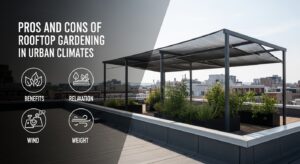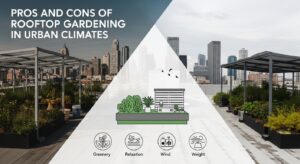Rooftop gardens have a significant impact on urban landscapes, serving as innovative solutions to environmental, aesthetic, and spatial challenges. As more people start to live and build green structures, rooftop gardening has grown from a small hobby to a city-wide trend. Many homeowners and designers are now exploring creative rooftop garden ideas to transform unused spaces into vibrant green retreats. But what are the upsides and downsides of growing a garden on top of a building in a city?
In this thorough guide, we’ll look at the pros and cons of rooftop gardening in urban climates.
Understanding Rooftop Gardening
Rooftop gardening means growing plants on the roofs of buildings. This idea turns unused rooftop space into green productive areas through basic container gardening or complex green roof systems.
There are two main types:
Extensive green roofs: Setups for mosses, herbs, and succulents that weigh less and need little upkeep.
Intensive green roofs:
- Thicker soil and stronger support lets you grow vegetables, shrubs, and even trees.
- The Upsides of Rooftop Gardening in City Areas.
1. Smart Use of Space
In packed cities where ground space is hard to find, rooftops offer an unused resource. Without building new land, rooftop gardens turn this space into a useful area.
Why it matters:
- Fights against urban sprawl.
- Gives purpose to unused spaces.
2. Better Air Quality
Plants clean the air naturally by taking in carbon dioxide and giving out oxygen. Rooftop gardens also catch dust, pollutants, and smog bits often found in city air.
Expert Insight:
The EPA says that plants in cities can cut down on floating particles in the air.
3. Less Urban Heat Island Effect
Cities are hotter than the nearby countryside because concrete and asphalt soak up heat. Rooftop gardens help balance this out by soaking up sunlight and cooling through water vapor from plants.
Benefits:
- Less need to cool indoor spaces.
- Lower temperatures across the city.
4. Stormwater Management
Urban areas face problems with runoff and flooding. Gardens on rooftops slow down rainwater flow, which helps municipal drainage systems cope better.
Data-backed Claim:
Green roofs can hold onto 70-90% of rainfall in summer and 25-40% in winter.
5. Enhanced Building Insulation
Vegetation on a rooftop works as insulation. It cuts down heat loss in winter and limits heat gain in summer, leading to energy savings.
Long-Term Impact:
- Lower HVAC costs.
- Longer roof life.
6. Promotion of Biodiversity
Rooftop gardens give birds, bees, and butterflies a home in cities where they often can’t find one. Even little gardens help create pathways for different creatures to move through the city.
Gardens become more valuable for nature when they include local plants and those that attract pollinators.
7. Benefits for Mind and Body
Being near green spaces helps people feel less stressed, happier, and more likely to be active. Rooftop gardens let city people escape from all the concrete around them.
Smart Tip: Just a little time spent in green spaces can lower stress hormones and make you feel better.
8. Chances to Grow Food in the City
From leafy greens to tomatoes and herbs, rooftop gardening can supply fresh produce. This boosts food security and local resilience.
Example:
Urban farms in New York City have changed unused rooftops into vegetable producers that work year-round.
9. Higher Property Value
A well-kept rooftop garden adds beauty and function to a property. This can make it worth more and attract buyers who care about the environment.
10. Learning and Community Involvement
Community rooftop gardens can teach schools, non-profits, and city people about sustainability and plant growing.
Pro Tip:
Grants and city programs can help fund shared rooftop garden projects.
Cons of Rooftop Gardening in Urban Climates
1. Engineering Challenges and Building Constraints
Many buildings can’t hold the extra weight of dirt, plants, and water. Experts must check the structure before adding a garden to an existing roof.
Risk:
Overlooking weight limits can damage the building or create dangers.
2. Steep Startup Expenses
Setting up rooftop gardens with full green roofs requires big money upfront for waterproofing, soil systems, pots, and watering.
Cost Breakdown:
- Building inspections
- Waterproof layers
- Water removal systems
- Special dirt and containers
3. Maintenance Requirements
The dream of a rooftop garden sounds great, but it needs constant care:
- Water and feed plants
- Control pests
- Manage plants each season
Reality Check:
Rooftops face more wind and sun, so plants need extra attention.
4. Access Issues
Not everyone can or can reach a rooftop. Stairs might be steep, ladders rickety, or doors locked.
Legal Stuff to Think About:
Make sure your rooftop use follows building rules and local laws.
5. Climate Challenges
City climates often have extremes like high winds, little shade, and heat bouncing off surfaces. These conditions challenge plants and might require wind barriers or ways to create shade.
6. Waterproofing and Drainage Risks
Bad installation can cause water to leak, hurting the building’s structure or letting mold grow.
Preventive Tip:
Always use barriers for roots, mats that protect, and layers that keep water out, all certified.
7. Few Plant Choices
Because of exposure and soil limits, not all plants do well on rooftops. Gardeners must pick species that can handle rooftop mini-climates.
8. Security and Liability Worries
In shared or commercial buildings, safety has a key impact. Risks include falling tools, unsecured pots, and unauthorized access.
Best Practice: Install railings, signs, and secure all items against wind.
9. Pest and Pollution Exposure
Rooftops might seem safe from pests, but birds, insects, and air pollutants can affect plant health.
Solution: Pick pest-resistant plants and use organic pest control.
10. Regulatory and Zoning Hurdles
Local laws may restrict rooftop changes in historic districts or buildings with shared ownership.
Checklist:
- Study the zoning laws.
- Check insurance coverage.
- Consult local environmental offices.
Tips for Successful Rooftop Gardening
- Start Small: Begin with containers and grow your garden over time.
- Get Expert Advice: Ask structural engineers and horticulturists for guidance.
- Use Lightweight Materials: Pick geotextiles, perlite, and coco coir.
- Invest in Irrigation: Drip irrigation systems help you save water and time.
- Select Resilient Plants: Focus on plants that can handle heat and dry spells.
- Keep Soil Healthy: Use pH meters and add nutrients to check soil condition.
- Provide Shade and Wind Protection: Use trellises and netting to protect fragile plants.
- Document Your Progress: Take pictures and make notes to keep track of what’s effective.
- Join Rooftop Gardening Groups to gain insights from others’ experiences.
- Stay Patient and Persistent: Just like all gardens, rooftop areas need time to thrive.
Conclusion: Does Rooftop Gardening Pay Off?
Rooftop gardening in city climates offers a blend of thrilling possibilities and actual hurdles. The benefits can be substantial, spanning from boosts to the environment and personal well-being to space optimization and visual appeal. Yet thorough planning, financial commitment, and upkeep are crucial for success in the long run. Rooftop gardens offer a powerful and exciting way for city folks to get back in touch with nature, grow their food, or help make the world a bit greener. The secret is to tackle the project with doable goals, reliable info, and tips from those who know their stuff.
Have you thought about starting a garden on your roof? What worries or questions are on your mind? Share your thoughts in the comments, and let’s work together to make our skyline greener or contact us!








